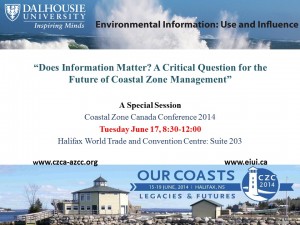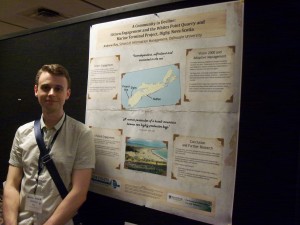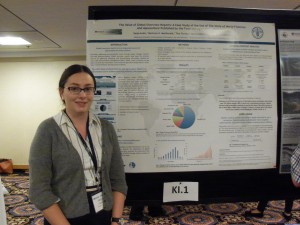 The value of evidence-based policy making cannot be overstated, according to speakers at the special session “Does Information Matter? A Critical Question for the Future of Coastal Zone Management” at the Coastal Zone Canada Conference 2014. This session was organized by the EIUI team and brought together eight scholars to address questions such as: Where does evidence come from? How does it make its way out of the laboratories and offices of scientists and other researchers into the minds and documents of policy- and decision-makers? Who is responsible for bridging the communication gap between these different groups? What enables information mobilization? What inhibits it? The most important question, however, is: how can the science-policy communication gap be bridged effectively?
The value of evidence-based policy making cannot be overstated, according to speakers at the special session “Does Information Matter? A Critical Question for the Future of Coastal Zone Management” at the Coastal Zone Canada Conference 2014. This session was organized by the EIUI team and brought together eight scholars to address questions such as: Where does evidence come from? How does it make its way out of the laboratories and offices of scientists and other researchers into the minds and documents of policy- and decision-makers? Who is responsible for bridging the communication gap between these different groups? What enables information mobilization? What inhibits it? The most important question, however, is: how can the science-policy communication gap be bridged effectively?
The eight scholars (see the titles of their papers below) addressed several issues in policy-making and made recommendations for improving research, knowledge mobilization, and policy-making. Key messages from the talks included:
- A communication gap exists between researchers and those in a position to make decisions or policy. Asking questions about the communication process helps to increase understanding of the enablers and barriers to communicating research findings (MacDonald et al.);
- Strategies to improve stakeholder information seeking in developing environmental knowledge can positively affect decision-making (Ascher and Ascher);
- Existing networks of individuals within and between organizations or projects often depend on few individuals to move knowledge through networks; efforts should be made to improve the connectivity of network actors (Hartley);
- Research salience could be improved by practicing user-inspired and outcome-oriented research with a higher degree of user engagement (McNie);
- The politicizing of science, though it may improve salience of information, is resulting in the watering-down of scientific recommendations, to the detriment of the marine environment (de Santo);
- Collaboration and overlapping membership contribute to strong networks with higher degrees of cross-organizational communication (Soomai);
- The idea of transparency is a one-way system; openness and accountability need to be involved in data delivery and access for all actors in public policy decisions (Graham); and
- Methods for measuring the use of information and a case study of a grey literature report were presented, illustrating the need for built-in monitoring frameworks in order to more accurately study the flow of information from creation to policy-making (Ross).
In the question period, discussion about the enablers and barriers to effective science-policy communication were dominant. All of the presenters spoke about how individuals within networks can be enablers or inhibiters of information flow. Moreover, information can be lost due to high employee turnover rates with the subsequent loss of corporate knowledge. This scenario makes it difficult for individuals to facilitate information transfer, even if they are motivated to do so. Concerns about how scientists are asked to communicate their findings were also raised. A perception exists that scientists are asked to communicate only the findings of their research without recommendations. Is scientific information losing its value because of this communication caveat? Perhaps not; policy makers are expected to balance many different factors and viewpoints of which the scientific is simply one of many.
The discussion concluded on a point about the audiences who receive and have access to research information. With the large volume of information available individuals may be relying more heavily on what others have told them rather than reading the research reports themselves. Information disseminated in this way is almost certainly filtered, but research on communication has shown that person-to-person communication often plays a larger role in information transfer than direct use of primary literature; this finding is perhaps why network analysis can be very informative for understanding and improving communication. Several of the speakers discussed strengthened personal communication: through studying networks (Hartley), or through enhancing user-engagement to improve research credibility (McNie), or even through cross-organizational roles (Soomai). Though perhaps not explicitly stated, each researcher discussed the importance of personal communication within an individual’s network to facilitate information transfer.
By the end of the well-attended session, I am sure that everyone was convinced that information does, in fact, matter. The flow of information, its dissemination and assimilation into policy and legislation occurs in a labyrinth that is difficult to follow. Despite the challenges of understanding the flow of information, it is possible to look at snapshots, or case studies, to gain an understanding about how the science-policy gap can be bridged.
Poster Session
In addition to the special session, EIUI researchers presented posters illustrating two case studies of information use. Andrew Roy presented a poster about the Environmental Impact Assessment of the proposed Digby Neck Quarry, Nova Scotia as a case study to explore how the interactions among governmental bodies, industry, environmental and community groups may affect the perception of objectivity and accuracy of the process producing the assessment documents. Vanja Avdic and co-authors presented a study on the use of a global overview report, namely, The State of World Fisheries and Aquaculture, which is the flagship publication of the Fisheries division of the Food and Agriculture Organization of the UN. This study demonstrates the value of continued research efforts to determine how scientific information is being used in order to strengthen communication about the information.
Papers
“Bridging the Science-Policy Gap in Marine Environmental Management”
Bertrum H. MacDonald, 1 Peter G. Wells, 1 Elizabeth M. De Santo, 2 & Suzuette S. Soomai1
1Dalhousie University, Halifax, NS; 2Franklin & Marshall College, Lancaster, PA
“Inducing More Effective Stakeholder Searches for Sound Environmental Information”
William Ascher, 1 & Diana Ascher, 2
1Claremont McKenna College, Claremont, CA; 2University of California, Los Angeles
“In the Eye of the Beholder: Scientific Uncertainty and Information Flow in Fisheries and Land-Use Governance Networks”
Troy Hartley
College of William and Mary, Gloucester, VI
“Designing Outcome-Oriented Research to Improve the Relevance of Environmental Science for Policy”
Elizabeth McNie
University of Colorado, Boulder, CO
“Communicating Complex Environmental Information in Political Contexts: Lessons Learned from the IPCC for IPBES and Marine Biodiversity Conservation”
Elizabeth M. De Santo
Franklin & Marshall College, Lancaster, PA
“Measuring Use of Fisheries Information in Policy-Making for Fisheries Management”
Suzuette S. Soomai
Dalhousie University, Halifax, NS
“Just Evidence: Governing Knowledge by Opening Data”
Janice Graham
Dalhousie University, Halifax, NS
“Awareness and Use of State of the Environment Reports: A Case Study of the State of the Scotian Shelf Report”
James Ross1 & Heather Breeze2
1Dalhousie University, Halifax, NS; 2Department of Fisheries and Oceans, Halifax, NS
Posters
“Working Towards Objectivity and Accuracy: The Process of Producing Environmental Impact Statements in the Digby Neck Quarry”
Andrew Roy
Dalhousie University, Halifax, NS
“The Value of Global Overview Reports: A Case Study on the Use of The State of World Fisheries and Aquaculture Published by the Food and Agricultural Organization”
Vanja Avdic,1 Bertrum H. MacDonald,1 Tina Farmer,2 Maria Kalentsits,2 and Richard Grainger2
1Dalhouse University, Halifax, NS; 2Food and Agricultural Organization, Rome
Author: Sarah Chamberlain


